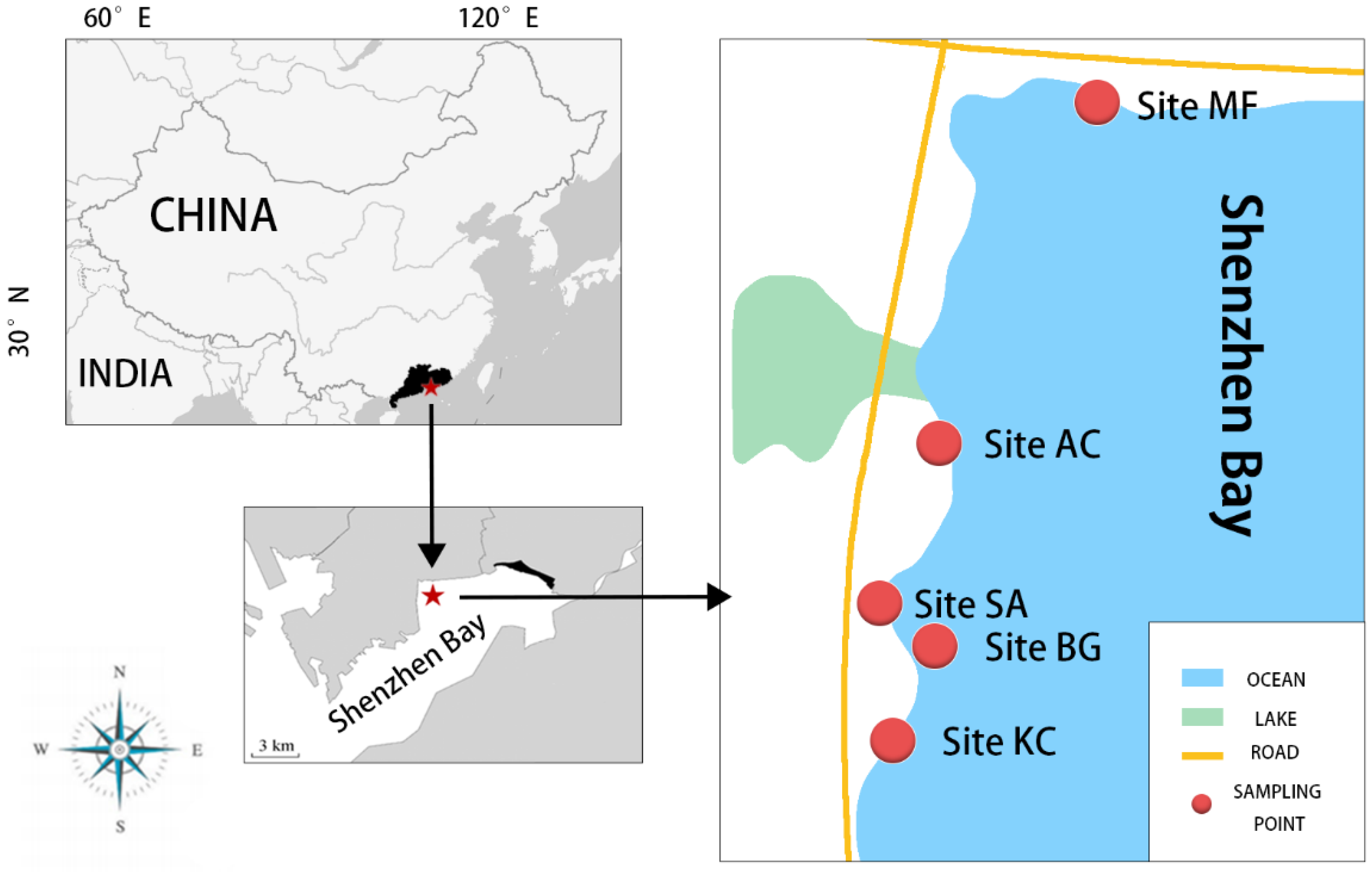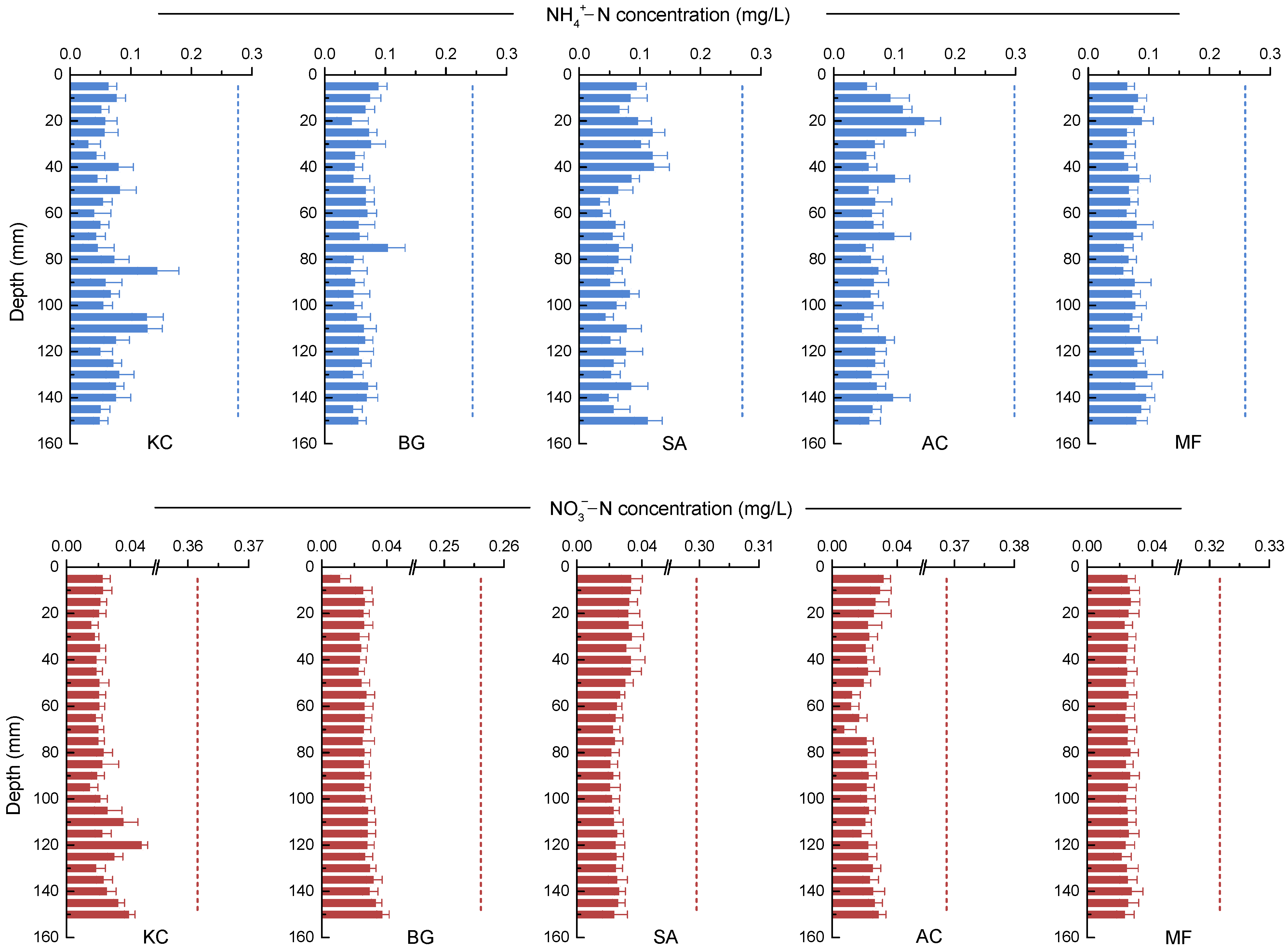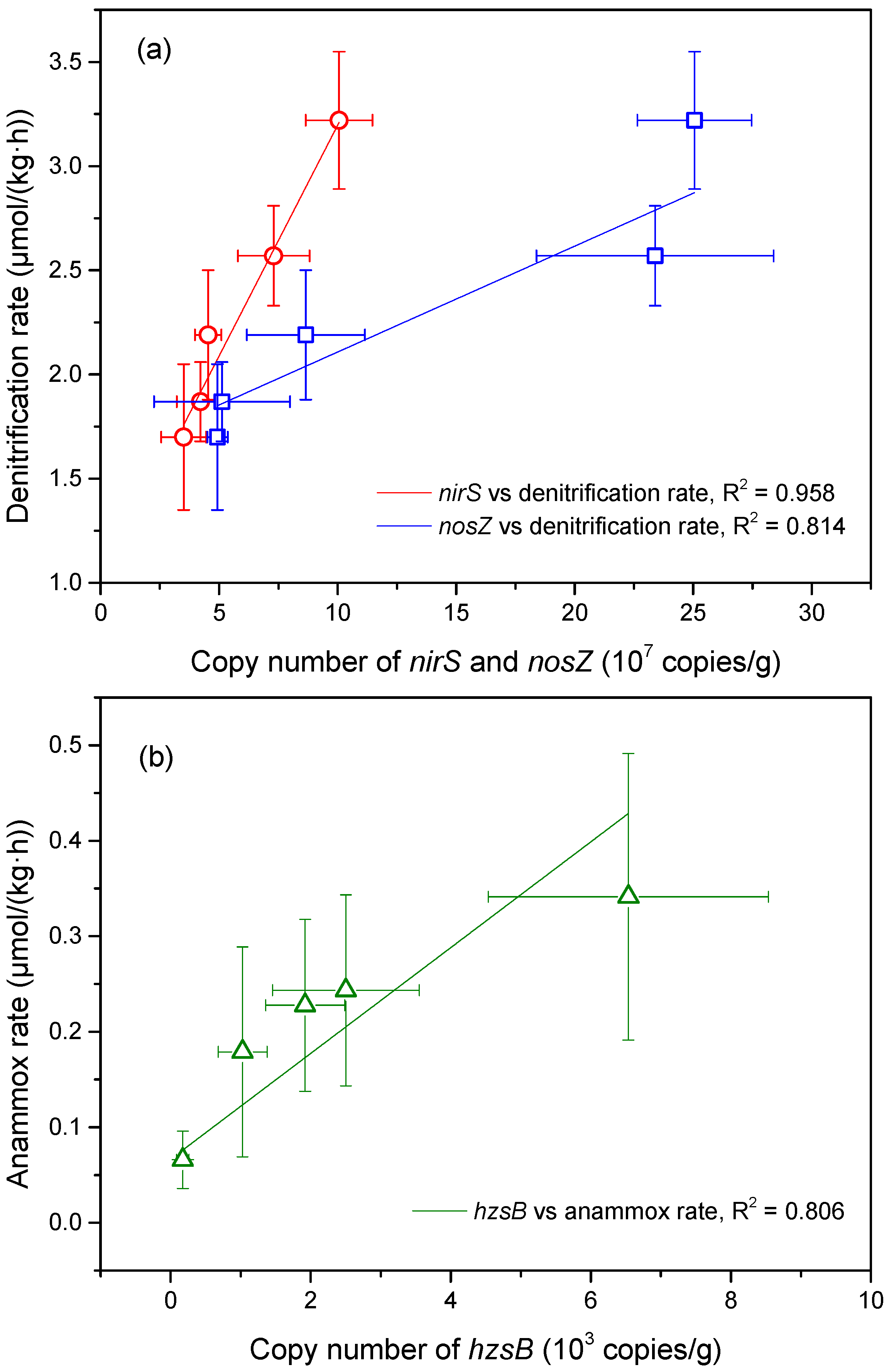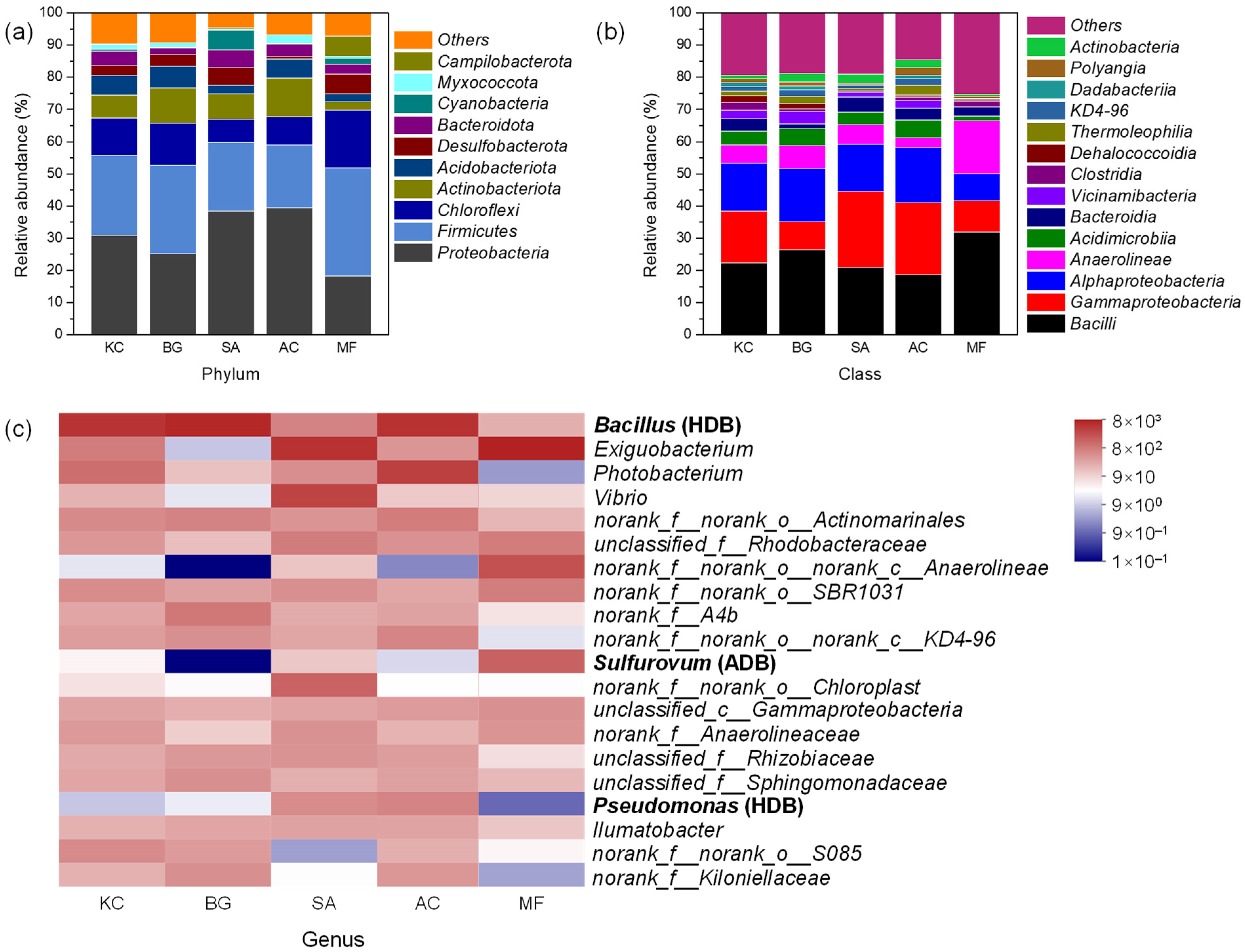Effect of Mangrove on Nitrogen Removal in the Intertidal Zone of Shenzhen’s Deep Bay: From 15N Isotope Tracing to Microbial Analysis
Abstract
1. Introduction
2. Materials and Methods
2.1. Study Sites
2.2. Sampling and Analysis
2.3. Measuring Denitrification, Anammox, and Dissimilatory Nitrate Reduction to Ammonium (DNRA) Rates
2.4. DNA Extraction and Quantitative PCR (q-PCR)
2.5. High-Throughput 16S rRNA Gene Sequencing and Analysis
3. Results and Discussion
3.1. Physical and Chemical Properties of Marine Water
3.2. Vertical Distribution of Soluble Nitrogen Species
3.3. Biological Nitrogen Removal
3.4. Nitrogen Removal Functional Genes
3.5. Microbial Communities Related to Nitrogen Removal
4. Conclusions
- (1)
- The ammonia and nitrate in marine water in five wetland systems were significantly removed, with the removal efficiencies ranging from 70.9% to 75.5% and 89.5% to 94.0%, respectively. Among them, Kandelia candel and Aegiceras corniculatum most significantly promoted ammonia and nitrate removal, respectively.
- (2)
- The denitrification and anammox rates of the five systems ranged from 1.70 to 3.22 μmol/(kg·h) and 0.07 to 0.36 μmol/(kg·h), respectively. The denitrification rates in the plant sites were 1.1–1.9 times that in the mud flat site, while the anammox rate in the mud flat site was 1.5–2.0 times those in the plant sites. These values indicate that mangroves promote denitrification but inhibit anammox.
- (3)
- The numbers of nirS, nosZ, and hzsB in the five systems ranged from 3.51 × 107 to 10.06 × 107, 4.93 × 107 to 25.1 × 107, and 0.17 × 103 to 6.54 × 103copies/g, respectively. The numbers of each gene showed an excellent and positive correlation with the rate of relevant processes.
- (4)
- Bacillus and Pseudomonas were the predominant heterotrophic denitrifying bacteria genera identified in the systems. The autotrophic denitrifying bacteria genus was Sulfurovum, while the only identified anammox genus was Candidatus Scalindua.
Supplementary Materials
Author Contributions
Funding
Data Availability Statement
Acknowledgments
Conflicts of Interest
References
- Dai, Y.; Lin, X.; Luo, Y.; Sun, J.; Tian, Y. Molecular analysis of microbial nitrogen transformation and removal potential in mangrove wetlands under anthropogenic nitrogen input. Sci. Total Environ. 2021, 773, 145632. [Google Scholar] [CrossRef] [PubMed]
- Michotey, V.; Méjean, V.; Bonin, P. Comparison of Methods for Quantification of Cytochrome cd1-Denitrifying Bacteria in Environmental Marine Samples. Appl. Environ. Microb. 2000, 66, 1564–1571. [Google Scholar] [CrossRef] [PubMed]
- Yuan, H.Z.; Jia, B.C.; Zeng, Q.F.; Zhou, Y.W.; Wu, J.; Wang, H.X.; Fang, H.; Cai, Y.W.; Li, Q. Dissimilatory nitrate reduction to ammonium (DNRA) potentially facilitates the accumulation of phosphorus in lake water from sediment. Chemosphere 2022, 303, 134664. [Google Scholar] [CrossRef] [PubMed]
- Hao, L.; Huang, J. Effect of Aquaculture Reclamation on Sediment Nitrates Reduction Processes in Mangrove Wetland. J. Marine Sci. Eng. 2022, 10, 857. [Google Scholar] [CrossRef]
- Zhao, L.; Fu, G.P.; Tang, J.; Wu, J.F.; Pang, W.C.; Guo, Z.P. Efficient nitrogen removal of mangrove constructed wetlands: Enhancing heterotrophic nitrification-aerobic denitrification microflora through quorum sensing. Chem. Eng. J. 2022, 430, 133048. [Google Scholar] [CrossRef]
- Leung, J.Y.S.; Cai, Q.H.; Tam, N.F.Y. Comparing subsurface flow constructed wetlands with mangrove plants and freshwater wetland plants for removing nutrients and toxic pollutants. Ecol. Eng. 2016, 95, 129–137. [Google Scholar] [CrossRef]
- Nie, S.Q.; Zhang, Z.F.; Mo, S.M.; Li, J.H.; He, S.; Kashif, M.; Liang, Z.W.; Shen, P.H.; Yan, B.; Jiang, C.J. Desulfobacterales stimulates nitrate reduction in the mangrove ecosystem of a subtropical gulf. Sci. Total Environ. 2021, 769, 144562. [Google Scholar] [CrossRef]
- Xiao, K.; Wu, J.; Li, H.; Hong, Y.; Wilson, A.M.; Jiao, J.J.; Shananan, M. Nitrogen fate in a subtropical mangrove swamp: Potential associationwith seawater-groundwater exchange. Sci. Total Environ. 2018, 635, 586–597. [Google Scholar] [CrossRef]
- Zhang, M.P.; Dai, P.L.; Lin, X.L.; Lin, L.A.; Hetharua, B.; Zhang, Y.M.; Tian, Y. Nitrogen loss by anaerobic ammonium oxidation in a mangrove wetland of the Zhangjiang Estuary, China. Sci. Total Environ. 2020, 698, 134291. [Google Scholar] [CrossRef]
- Baskaran, V.; Prabavathy, V.R. Diverse key nitrogen cycling genes nifH, nirS and nosZ associated with Pichavaram mangrove rhizospheres as revealed by culture-dependent and culture-independent analyses. Arch. Microbiol. 2022, 204, 109. [Google Scholar] [CrossRef]
- Margulies, M.; Egholm, M.; Altman, W.E.; Attiya, S.; Bader, J.S.; Bemben, L.A.; Berka, J.; Braverman, M.S.; Chen, Y.J.; Chen, Z.T.; et al. Genome sequencing in microfabricated high-density picolitre reactors. Nature 2005, 437, 376–380. [Google Scholar] [CrossRef] [PubMed]
- Deng, F.Y.; Hou, L.J.; Liu, M.; Zheng, Y.L.; Yin, G.Y.; Li, X.F.; Lin, X.B.; Chen, F.; Gao, J.; Jiang, X.F. Dissimilatory nitrate reduction processes and associated contribution to nitrogen removal in sediments of the Yangtze Estuary. J. Geophys. Res. Biogeosci. 2015, 120, 1521–1531. [Google Scholar] [CrossRef]
- Risgaard-Petersen, N.; Meyer, R.L.; Schmid, M.; Jetten, M.S.M.; Enrich- Prast, A.; Rysgaard, S.; Revsbech, N.P. Anaerobic ammonium oxidation in an estuarine sediment. Aquat. Microb. Ecol. 2004, 36, 293–304. [Google Scholar] [CrossRef]
- Yin, G.Y.; Hou, L.J.; Liu, M.F.; Liu, Z.F.; Gardner, W.S. A Novel Membrane Inlet Mass Spectrometer Method to Measure 15NH4+ for Isotope-Enrichment Experiments in Aquatic Ecosystems. Environ. Sci. Technol. 2014, 48, 9555–9562. [Google Scholar] [CrossRef] [PubMed]
- Shan, J.; Zhao, X.; Sheng, R.; Xia, Y.Q.; Ti, C.P.; Quan, X.F.; Wang, S.W.; Wei, W.X.; Yan, X.Y. Dissimilatory nitrate reduction processes in typical Chinese paddy soils: Rates, relative contributions, and influencing factors. Environ. Sci. Technol. 2016, 50, 9972–9980. [Google Scholar] [CrossRef] [PubMed]
- Wang, H.T.; Gilbert, J.A.; Zhu, Y.G.; Yang, X.R. Salinity is a key factor driving the nitrogen cycling in the mangrove sediment. Sci Total Environ. Sci. Total Environ. 2018, 631, 1342–1349. [Google Scholar] [CrossRef]
- Soares, M.I.M. Biological Denitrification of Groundwater. Water Air Soil Pollut. 2000, 123, 183–193. [Google Scholar] [CrossRef]
- Chen, C.; Wang, A.J.; Ren, N.Q.; Kan, H.J.; Lee, D.J. Biological breakdown of denitrifying sulfide removal process in high-rate expanded granular bed reactor. Appl. Microbiol. Biotechnol. 2008, 81, 765–770. [Google Scholar] [CrossRef]
- Jin, R.C.; Yang, G.F.; Yu, J.J.; Zheng, P. The inhibition of the Anammox process: A review. Chem. Eng. J. 2012, 197, 67–79. [Google Scholar] [CrossRef]
- Kuenen, J.G. Anammox bacteria: From discovery to application. Nat. Rev. Microbiol. 2008, 6, 320–326. [Google Scholar] [CrossRef]
- Xi, H.P.; Zhou, X.T.; Arslan, M.; Luo, Z.J.; Wei, J.; Wu, Z.R.; El-Dinb, M.G. Heterotrophic nitrification and aerobic denitrification process: Promising but a long way to go in the wastewater treatment. Sci. Total Environ. 2022, 805, 150212. [Google Scholar] [CrossRef] [PubMed]
- Deng, Y.F.; Wu, D.; Huang, H.; Cui, Y.X.; Van Loosdrecht, M.C.; Chen, G.H. Exploration and verification of the feasibility of sulfide-driven partial denitrification coupled with anammox for wastewater treatment. Water Res. 2021, 193, 116905. [Google Scholar] [CrossRef] [PubMed]
- Ding, S.; Zheng, P.; Lu, H.F.; Chen, J.W.; Mahmood, Q.; Abbas, G. Ecological characteristics of anaerobic ammonia oxidizing bacteria. Appl. Microbiol. Biotechnol. 2013, 97, 1841–1849. [Google Scholar] [CrossRef] [PubMed]
- Li, B.L.; Wang, Y.; Li, J.T.; Yang, L.; Li, X.; Zhou, Z.; Li, Y.; Chen, X.G.; Wu, L. The symbiosis of anaerobic ammonium oxidation bacteria and heterotrophic denitrification bacteria in a size-fractioned single-stage partial nitrification/anammox reactor. Biochem. Eng. J. 2019, 151, 107353. [Google Scholar] [CrossRef]
- Ma, H.R.; Li, J.T.; Dong, H.Y.; Qiang, Z.M. Insights into microbial community variability and functional genes of various Candidatus Scalindua-based anammox processes treating nitrogen-rich saline wastewater. Sci. Total Environ. 2021, 766, 142544. [Google Scholar] [CrossRef] [PubMed]







| Primers | Specificity | Sequence (5′ to 3′) | Reference |
|---|---|---|---|
| nirSCd3aF | nirS gene | GTSAACGTSAAGGARACSGG | [2] |
| nirSR3cd | GASTTCGGRTGSGTCTTGA | ||
| nosZ-F | nosZ gene | CGYTGTTCMTCGACAGCCAG | [16] |
| nosZ-1622R | CGSACCTTSTTGCCSTYGCG | ||
| hzsB396F | hzsB gene | WTYGGKTATCARTATGTAG | [9] |
| hzsB742R | AAABGGYGAATCATARTGGC | ||
| nrfAF2aw | nrfA gene | CARTGYCAYGTBGARTA | [3] |
| nrfAR1 | TWNGGCATRTGRCARTC |
| Sampling Site | pH | COD (mg/L) | DO (mg/L) | Salinity (mg/L) | Ammonia Nitrogen (mg/L) | Nitrite Nitrogen (mg/L) | Nitrate Nitrogen (mg/L) | Total Inorganic Nitrogen (mg/L) | Sulfate (mg/L) |
|---|---|---|---|---|---|---|---|---|---|
| Kandelia candel site | 8.4 ± 0.4 | 4.4 ± 0.3 | 2.45 ± 0.26 | 31655 ± 819 | 0.277 ± 0.024 | 0.098 ± 0.007 | 0.256 ± 0.015 | 0.631 ± 0.041 | 1215 ± 77 |
| Bruguiera gymnorrhiza site | 9.0 ± 0.6 | 2.8 ± 0.1 | 4.20 ± 0.24 | 33735 ± 983 | 0.244 ± 0.012 | 0.149 ± 0.018 | 0.362 ± 0.020 | 0.755 ± 0.006 | 1425 ± 91 |
| Sonneratia apetala site | 8.5 ± 0.8 | 1.8 ± 0.1 | 2.84 ± 0.11 | 30160 ± 782 | 0.269 ± 0.009 | 0.142 ± 0.014 | 0.300 ± 0.011 | 0.711 ± 0.028 | 1510 ± 87 |
| Aegiceras corniculatum site | 8.3 ± 0.3 | 3.2 ± 0.2 | 4.22 ± 0.28 | 29445 ± 721 | 0.298 ± 0.012 | 0.149 ± 0.013 | 0.369 ± 0.014 | 0.816 ± 0.012 | 1335 ± 84 |
| Mud flat site | 9.3 ± 0.4 | 2.0 ± 0.2 | 3.35 ± 0.14 | 37505 ± 114 | 0.259 ± 0.010 | 0.052 ± 0.007 | 0.322 ± 0.013 | 0.633 ± 0.022 | 1535 ± 79 |
| Sampling site | Chao | Shannon | Coverage |
|---|---|---|---|
| Kandelia candel site | 1230 | 5.98 | 0.95 |
| Bruguiera gymnorrhiza site | 1226 | 5.71 | 0.95 |
| Sonneratia apetala site | 1344 | 6.08 | 0.95 |
| Aegiceras corniculatum site | 1069 | 5.36 | 0.94 |
| Mud flat site | 880 | 4.91 | 0.94 |
Publisher’s Note: MDPI stays neutral with regard to jurisdictional claims in published maps and institutional affiliations. |
© 2022 by the authors. Licensee MDPI, Basel, Switzerland. This article is an open access article distributed under the terms and conditions of the Creative Commons Attribution (CC BY) license (https://creativecommons.org/licenses/by/4.0/).
Share and Cite
Jin, X.; Fu, J.; Yang, J.; Guo, J.; Guo, W.; Chen, Y. Effect of Mangrove on Nitrogen Removal in the Intertidal Zone of Shenzhen’s Deep Bay: From 15N Isotope Tracing to Microbial Analysis. Water 2022, 14, 3507. https://doi.org/10.3390/w14213507
Jin X, Fu J, Yang J, Guo J, Guo W, Chen Y. Effect of Mangrove on Nitrogen Removal in the Intertidal Zone of Shenzhen’s Deep Bay: From 15N Isotope Tracing to Microbial Analysis. Water. 2022; 14(21):3507. https://doi.org/10.3390/w14213507
Chicago/Turabian StyleJin, Xinwei, Jingjing Fu, Juan Yang, Jing Guo, Wenrui Guo, and Yahui Chen. 2022. "Effect of Mangrove on Nitrogen Removal in the Intertidal Zone of Shenzhen’s Deep Bay: From 15N Isotope Tracing to Microbial Analysis" Water 14, no. 21: 3507. https://doi.org/10.3390/w14213507
APA StyleJin, X., Fu, J., Yang, J., Guo, J., Guo, W., & Chen, Y. (2022). Effect of Mangrove on Nitrogen Removal in the Intertidal Zone of Shenzhen’s Deep Bay: From 15N Isotope Tracing to Microbial Analysis. Water, 14(21), 3507. https://doi.org/10.3390/w14213507






